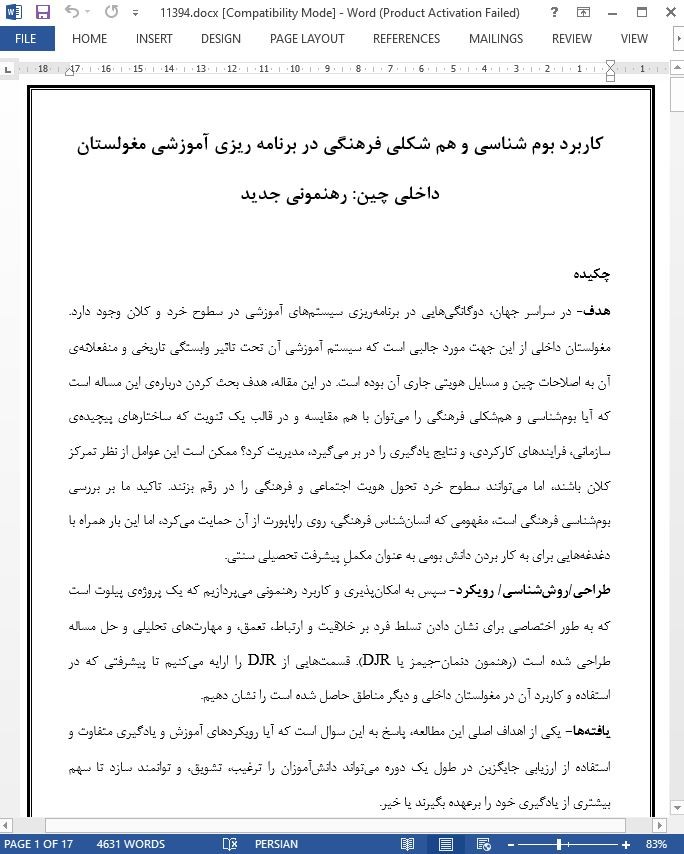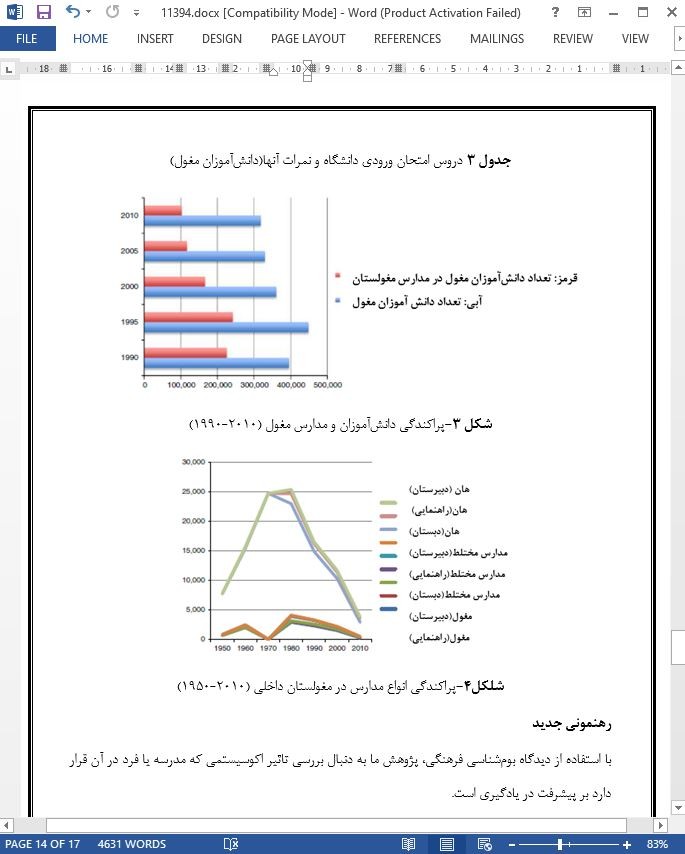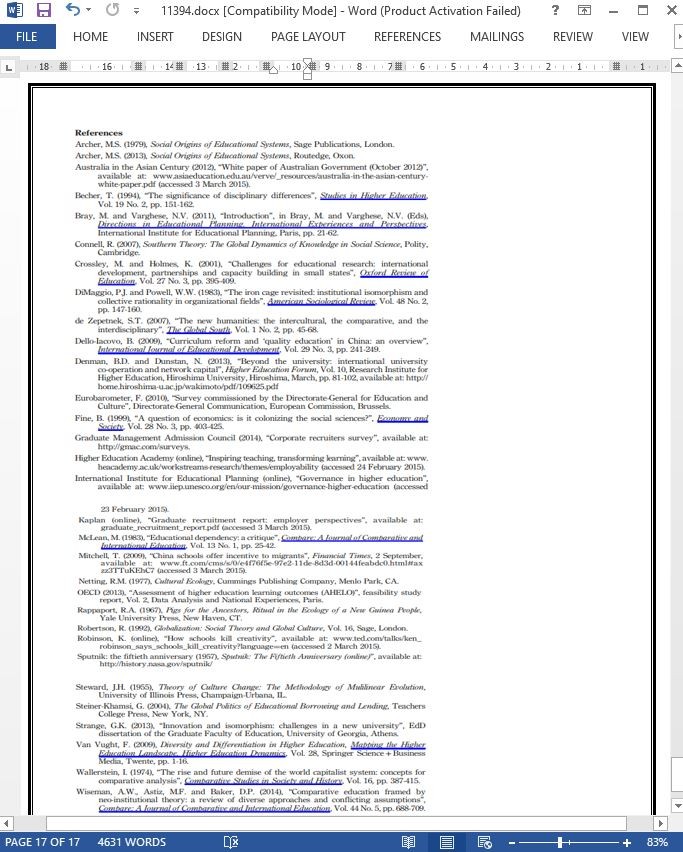
كاربرد بوم شناسی و هم شكلی فرهنگی در برنامه ريزی آموزشی مغولستان داخلی چين
چكيده
هدف- در سراسر جهان، دوگانگيهايي در برنامهريزي سيستمهاي آموزشي در سطوح خرد و كلان وجود دارد. مغولستان داخلي از اين جهت مورد جالبي است كه سيستم آموزشي آن تحت تاثير وابستگي تاريخي و منفعلانهي آن به اصلاحات چين و مسايل هويتي جاري آن بوده است. در اين مقاله، هدف بحث كردن دربارهي اين مساله است كه آيا بومشناسي و همشكلي فرهنگي را ميتوان با هم مقايسه و در قالب يك ثنويت كه ساختارهاي پيچيدهي سازماني، فرايندهاي كاركردي، و نتايج يادگيري را در بر ميگيرد، مديريت كرد؟ ممكن است اين عوامل از نظر تمركز كلان باشند، اما ميتوانند سطوح خرد تحول هويت اجتماعي و فرهنگي را در رقم بزنند. تاكيد ما بر بررسي بومشناسي فرهنگي است، مفهومي كه انسانشناس فرهنگي، روي راپاپورت از آن حمايت ميكرد، اما اين بار همراه با دغدغههايي براي به كار بردن دانش بومي به عنوان مكملِ پيشرفت تحصيلي سنتي.
طراحي/روششناسي/ رويكرد- سپس به امكانپذيري و كاربرد رهنموني ميپردازيم كه يك پروژهي پيلوت است كه به طور اختصاصي براي نشان دادن تسلط فرد بر خلاقيت و ارتباط، تعمق، و مهارتهاي تحليلي و حل مساله طراحي شده است (رهنمون دنمان-جيمز يا DJR). قسمتهايي از DJR را ارايه ميكنيم تا پيشرفتي كه در استفاده و كاربرد آن در مغولستان داخلي و ديگر مناطق حاصل شده است را نشان دهيم.
يافتهها- يكي از اهداف اصلي اين مطالعه، پاسخ به اين سوال است كه آيا رويكردهاي آموزش و يادگيري متفاوت و استفاده از ارزيابي جايگزين در طول يك دوره ميتواند دانشآموزان را ترغيب، تشويق، و توانمند سازد تا سهم بيشتري از يادگيري خود را برعهده بگيرند يا خير.
بديع بودن/ارزش پژوهش- اين روايت نگاه تازهاي است به سيستم آموزشي مغولستان داخلي، و تاثير پذيري آن از وابستگي تاريخي و منفعلانه بر اصلاحات و مشكلات هويتي فعلي چين.
كارايي در دنياي واقعي: دو مفهوم
مفهوم اول: بومشناسي فرهنگي
بومشناسي فرهنگي محصول منطقي پيشرفتهاي خاصي در حيطهي انسانشناسي است (نتينگ،1988، ص 4) كه ديگر تنها به محيط فيزيكي يا اكوسيستم مربوط نميشود. بومشناسي فرهنگي به رفتار انسان به عنوان پاسخي مجزا به موقعيتهاي بخصوص درون يك اكوسيستم نگاه ميكند. از زماني كه استوارت (1955) براي اولين بار اين اصطلاح را در كتاب خود، نظريهي تغيير فرهنگ، به كار برد، انسانشناسان تعريف آن را گسترش دادهاند، به طوري كه امروزه مفاهيم انتزاعيتر اجتماعي مانند اقتصاد سياسي و اجتماعي را در بر ميگيرد، و از آن براي مطالعهي مفاهيم و كاربست قدرت و منابع (كژروي) استفاده كردهاند. اين تغيير دادن تعريف به اين دليل اتفاق افتاد كه در تعريف قبلي بهاي كمي به همهشمولي داده شده بود، و محققين از صورتبندي ارزشها و گونههاي فرهنگي راضي نبودند، كه باعث شد انسانشناسان مبناي شواهد مطالعاتشان را بر ارتباطات بومشناختي فراگيرتر و سيستماتيكتر بگذارند (نتينگ،1977، ص 6).
رهنموني جديد
با استفاده از ديدگاه بومشناسي فرهنگي، پژوهش ما به دنبال بررسي تاثير اكوسيستمي كه مدرسه يا فرد در آن قرار دارد بر پيشرفت در يادگيري است.
ما يك مدل ارزيابي تكويني جايگزين به نام رهنمون دنمان-جيمز (DJR) طراحي كردهايم، نوعي وسيلهي ارزيابي تصويري آنلاين كه پيشرفت دانشآموز را در هر درس، زمينه يا مهارتي را دنبال ميكند و شواهدي براي اندازهگيري و چهارچوب بندي كسب دانش ارايه مي كند. ما با دانشگاه مينزو از چين، و دانشگاه عادي مغولستان داخلي (InnerMongolia Normal University) براي آزمودن اين رويكرد ناهمشكلگرا كه از نظر فرهنگي حساستر است همكاري كرده، و آن را براي بهبود پيشرفت تحصيلي دانشجويان اقليت قومي به كار بستهايم.
Abstract
Purpose – Worldwide, dichotomies exist within macro- and micro-educational planning of systems of education. Inner Mongolia represents an interesting case in the sense that its educational system has been influenced by its historical and passive reliance on China’s political reforms and ongoing identity issues. The purpose of this paper is to discuss how cultural ecology and isomorphism can be compared and managed in the form of a dualism, involving complex organisational structures, operational procedures, and learning outcomes. These may be macro in focus but may also promote the development of social and cultural identity at micro levels. Emphasis is placed upon examining cultural ecology, a concept advocated by the cultural anthropologist, Roy Rappaport, but with concern for embracing indigenous knowledge as a complement to traditional educational attainment.
Design/methodology/approach – This discussion further considers the feasibility and implementation of a rubric (the Denman-James Rubric (DJR)) that is a custom-tailored pilot project designed to visually demonstrate one’s mastery of creativity and communication, reflective thinking, and analytical and problem solving skills. A demonstration of the DJR is presented to highlight the progress made in its usage and utility in Inner Mongolia and elsewhere.
Findings – A primary research goal is to investigate whether differing teaching and learning approaches and the use of alternative assessments over a period of time can promote, encourage, and empower students into taking greater ownership of their learning.
Originality/value – This narrative is an original look at Inner Mongolia’s educational system and how it has been influenced by its historical and passive reliance on China’s political reforms and ongoing identity issues.
Real world applicability: two concepts Concept
1: cultural ecology
Cultural ecology is a logical outgrowth of certain developments in anthropology (Netting, 1977, p. 4) that no longer relate to just the physical environment or ecosystem. It views human behaviour as a distinctive response to specific contexts within an ecosystem. Since Steward’s (1955) initial use of the term in his book, Theory of Culture Change, anthropologists have expanded the definition to include more abstract social concepts such as political and social economy and applied it to studying the concepts and applications of power and resources (divergence). This modification in definition came in response to an undervaluation of inclusivity and dissatisfaction with formulations of cultural values and types, which prompted anthropologists to evidence base their research on wider-ranging and systematic ecological relationships (Netting, 1977, p. 6).
A new rubric
Adopting a cultural ecology perspective, our research seeks to examine how the influences of the ecosystem in which a school or individual nests impacts on achievement in learning.
We have designed an alternative, formative assessment model, the Denman-James Rubric (DJR), as an online visual assessment tool that tracks a student’s progressive achievement in any course, subject or skill and provides an evidence base for measuring and scaffolding knowledge acquisition. We have been collaborating with Minzu University of China, and Inner Mongolia Normal University to trial this non-isomorphic, more culturally sensitive approach by applying it to improving educational attainments for ethnic minority students.
چكيده
كارايي در دنياي واقعي: دو مفهوم
مفهوم اول: بومشناسي فرهنگي
مفهوم دوم: همشكلي
تاثيرات بر آموزش
برنامهريزي آموزشي
تحصيلات دانشگاهي
كاربرد اين مبحث در مورد چين
مغولستان داخلي
رهنموني جديد
Abstract
Real world applicability: two concepts
Concept 1: cultural ecology
Concept 2: isomorphism
Implications for education
Educational planning
Higher education
Application of the discussion to the Chinese context
Inner Mongolia
A new rubric
- اصل مقاله انگلیسی با فرمت ورد (word) با قابلیت ویرایش
- ترجمه فارسی مقاله با فرمت ورد (word) با قابلیت ویرایش، بدون آرم سایت ای ترجمه
- ترجمه فارسی مقاله با فرمت pdf، بدون آرم سایت ای ترجمه



